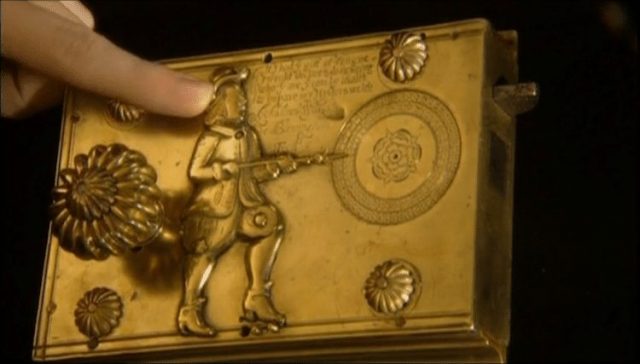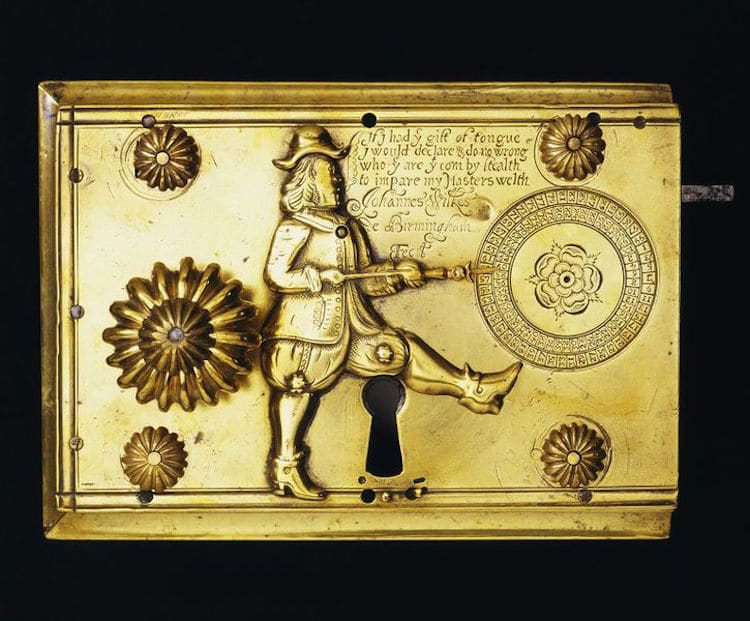This 17th century lock is part-security measure and part-work of art! Created by a John Wilkes (or Iohannes Wilkes) in Birmingham England, it dates back to 1680 and is known as a “detector lock”.
The mechanism detects the number of times it’s been unlocked. How so? Wilkes’ design depicts a gentleman holding a pointing implement.
Things get interactive when a button is pushed, swinging the figure’s leg up on a miniature pivot. His nifty move isn’t just for show. The metal limb obscures a key hole!

For an added flourish of safeguarding savvy, the man’s hat can be tilted, releasing the bolt. Once the lock is used, a dial to the man’s right turns so he points at the latest tally.
The Victoria and Albert Museum (V & A) – where the extraordinary piece can be found, though it’s on display rather than protecting any treasures – mentions that “his toe points to an odd number on the inner ring.”
Much more interesting than simply jangling a key in a door. Wilkes’ lock is fashioned from steel and brass, with the key made of cast steel. This is where different types are blended together, giving the item extra strength. It has a height of 11.3 cm and a width of 15.5, which increases to 17 cm when the lock is out.

Where was the lock intended for? On website My Modern Met, Jessica Stewart writes it was “fitted to the door of a private closet, where important business took place or valuables were stored, ensuring maximum security in all situations.”
If the presence of this beautiful yet heavy duty mechanism wasn’t enough to deter thieves, then the inscription may have helped keep them away. The Museum’s online listing quotes this historic ticking off: “IF I HAD YE GIFT OF TONGUE | I WOULD DECLARE AND DO NO WRONG | WHO YE ARE YT COME BY STEALTH | TO IMPARE MY MASTER’S WELTH”.
The V & A adds Wilkes’ impressive effort was made during an “increasingly sophisticated” period for the art of locksmithing: 1600 – 1700.
His ways with home security didn’t end here. Over in New York, the Metropolitan Museum of Art displays a lock of similar construction. Wilkes crafted this piece around the same time.
It shows brass flowers and assorted plant life stemming from some kind of vessel. The key which accompanies it could almost be a movie prop! Wilkes passed away in 1732, but his legacy appears to be felt across the globe.
Elsewhere at the V & A, 17th century barrel padlocks from Sweden can be viewed. The website Historical Locks describes how they were made during the rein of King Gustav Vasa.
Barrel padlocks came with swing shackle joints and ward springs. Sounds less elaborate than other examples, though expert craftsmanship is clearly in evidence.
Historical Locks writes they had “reinforcement bands or rings welded on”, and these featured “punched or chiseled patterns”.
The site continues: “The shackle usually has an elegant curlicue at the transition to the arch”. A curlicue is a curl or twist used for decorative purposes.
Of course, the locksmiths’ trade goes beyond the past few hundred years. In fact the profession stretches right back to Ancient Egypt and Babylon, according to History of Keys. Things were basic to begin with. The site refers to a wooden design that required a “large and cumbersome wooden key (created in the shape of modern toothbrush)” to open it.
Another Article From Us: Ekranoplan: The Only Lun Ever Built, Lies Stranded in the Caspian Sea
Things really took off in the 18th century, thanks to the “adoption of advanced metallurgy”. A bit after Wilkes’ time, though he may have lived to appreciate the fruits of his lock-based labors. In these troubled times, it’s interesting to take a look at a very different kind of key worker!
